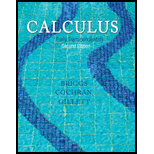
Concept explainers
U.S. population projections According to the U.S. Census Bureau, the nation’s population (to the nearest million) was 281 million in 2000 and 310 million in 2010. The Bureau also projects a 2050 population of 439 million. To construct a logistic model, both the growth rate and the carrying capacity must be estimated. There are several ways to estimate these parameters. Here is one approach:
a. Assume that t = 0 corresponds to 2000 and that the population growth is exponential for the first ten years; that is, between 2000 and 2010, the population is given by P(t) = P(0)ert. Estimate the growth rate r using this assumption.
b. Write the solution of the logistic equation with the value of r found in part (a). Use the projected value P(50) = 439 million to find a value of the carrying capacity K.
c. According to the logistic model determined in parts (a) and (b), when will the U.S. population reach 95% of its carrying capacity?
d. Estimations of this kind must be made and interpreted carefully. Suppose the projected population for 2050 is 450 million rather than 439 million. What is the value of the carrying capacity in this case?
e. Repeat part (d) assuming the projected population for 2050 is 430 million rather than 439 million. What is the value of the carrying capacity in this case?
f. Comment on the sensitivity of the carrying capacity to the 40-year population projection.
Want to see the full answer?
Check out a sample textbook solution
Chapter D1 Solutions
Calculus: Early Transcendentals, 2nd Edition
- Example: If ƒ (x + 2π) = ƒ (x), find the Fourier expansion f(x) = eax in the interval [−π,π]arrow_forwardExample: If ƒ (x + 2π) = ƒ (x), find the Fourier expansion f(x) = eax in the interval [−π,π]arrow_forwardPlease can you give detailed steps on how the solutions change from complex form to real form. Thanks.arrow_forward
- Examples: Solve the following differential equation using Laplace transform (e) ty"-ty+y=0 with y(0) = 0, and y'(0) = 1arrow_forwardExamples: Solve the following differential equation using Laplace transform (a) y" +2y+y=t with y(0) = 0, and y'(0) = 1arrow_forwardπ 25. If lies in the interval <0arrow_forwardarrow_back_iosSEE MORE QUESTIONSarrow_forward_ios

 Glencoe Algebra 1, Student Edition, 9780079039897...AlgebraISBN:9780079039897Author:CarterPublisher:McGraw HillAlgebra & Trigonometry with Analytic GeometryAlgebraISBN:9781133382119Author:SwokowskiPublisher:Cengage
Glencoe Algebra 1, Student Edition, 9780079039897...AlgebraISBN:9780079039897Author:CarterPublisher:McGraw HillAlgebra & Trigonometry with Analytic GeometryAlgebraISBN:9781133382119Author:SwokowskiPublisher:Cengage


